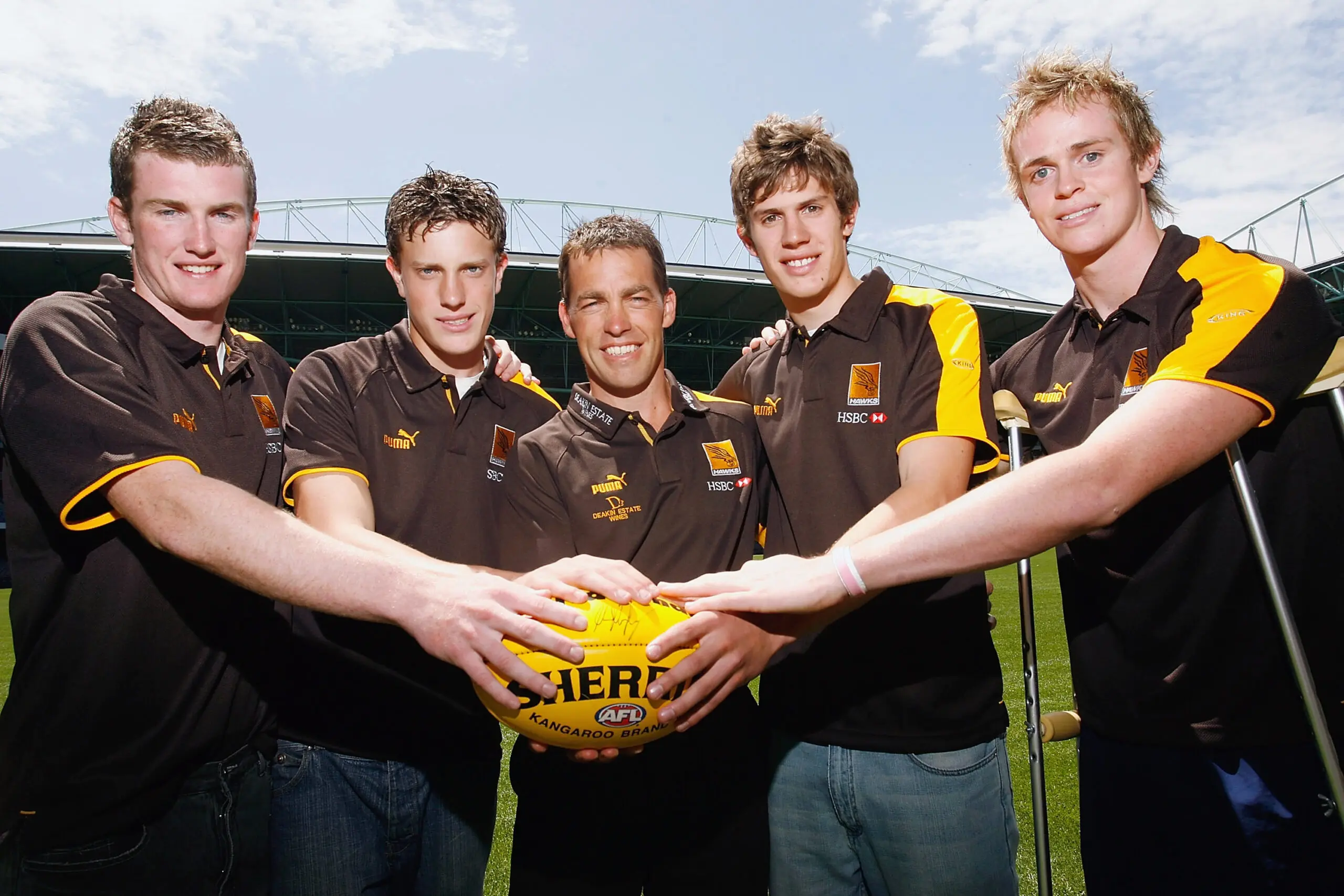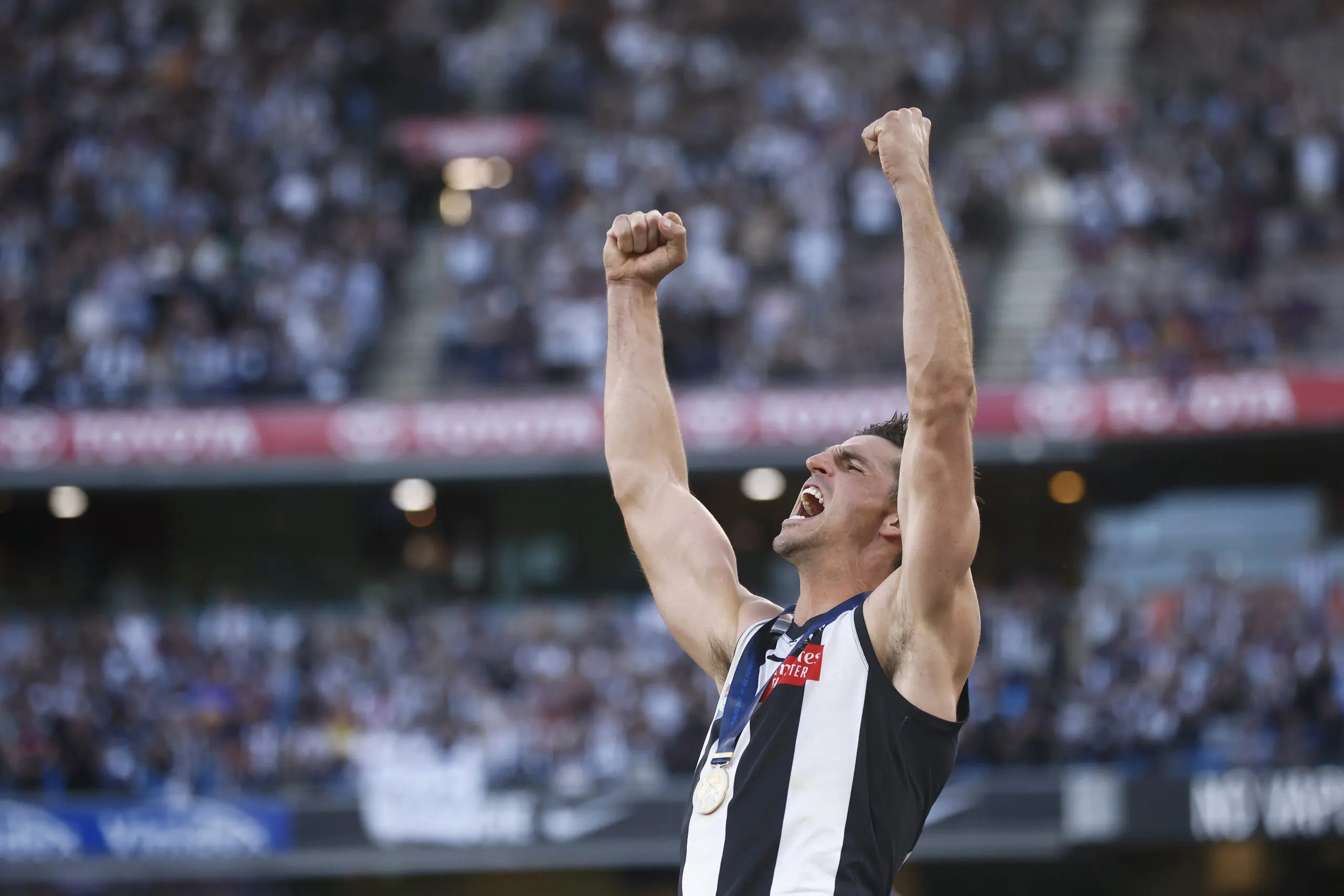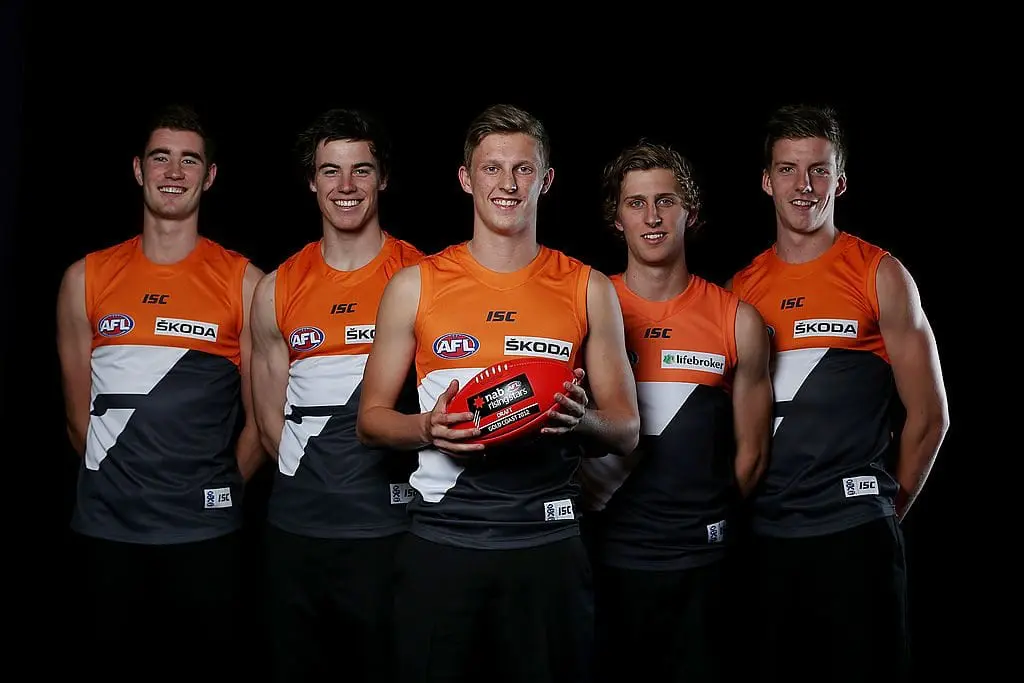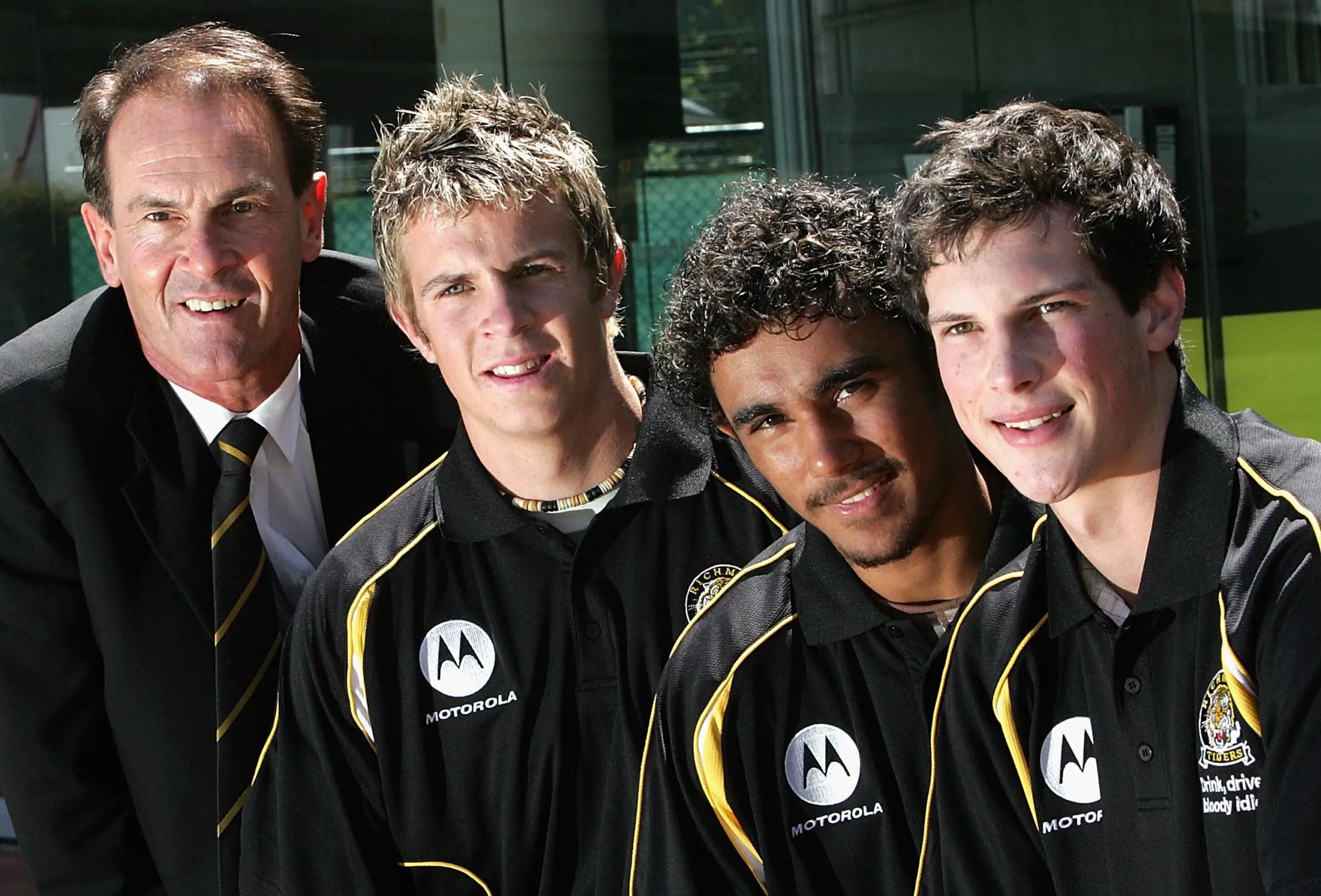Armed with a bandolier of first-round picks, draped threateningly across his brown and gold polo, Alastair Clarkson is sure to have had a thought crossing his mind, again and again, like a news ticker.
'Lightning can strike in the same place twice, right?'
A year after he and the Hawks pulled cottontail after cottontail out of their hat, selecting Jarryd Roughead, Lance Franklin and Jordan Lewis with their three first-round selections, Clarkson and company were back at the Telstra Dome, this time for the 2005 AFL Draft; this time holding four opening round picks.
Packing Picks 3, 6, 14 and 18 into the chamber, the Hawks, under the guidance of Clarkson, list boss Chris Pelchen and recruiting chief Gary Buckenara, scratched an itchy trigger finger, firing off all four in a bid to blast memories of a 5-17 season to smithereens.
Yet as the dust began to settle in the seasons that followed that November day, it became clear that while Clarkson's pistols were in working order, his bullets, for the most part, had been blanks.

At Pick 3, Hawthorn made Xavier Ellis a Hawk, repeating the process to successfully bring Beau Dowler, Grant Birchall and Max Bailey to their new training base at Waverley.
Though underwhelming in hindsight, the whiffs have only taken on more pungency in the decade and change to come, with each of Josh Kennedy, Scott Pendlebury, Paddy Ryder, Shaun Higgins, Nathan Jones, Shannon Hurn, Travis Varcoe and Richard Douglas passed on in the first-round alone.
The numbers aren't kind either.
Of the 19 players that were selected with first-round picks during the 2005 draft, each went on to play a combined total of 2823 games for the clubs that initially selected them.
Hawthorn's contribution? 393 of them or 13.92 per cent of the whole. If Birchall's 248 games in brown and gold are shaved, this is worked back to 5.13 per cent. Add in that the Hawks' used more than 21 per cent of the first-round picks that year, and it's enough to make eyes water.
All thunder and no lightning, then.
Four flags, 18 years and a change of scenery later, Clarkson is back at it again, with his Kangaroos currently holding five first-round picks to spend on five bluechip kids, each ironically born in 2005, at November's National Draft.
Outside of expansion drafts, or the Giants' hand of five used during the 2012 AFL Draft, the size of North's current arsenal - comprised of Picks 2, 3, 15, 17, 18, 57 and 65 - is unprecedented.
Despite underperfoming on-field of late, North Melbourne has enjoyed good form at the draft in recent seasons, selecting a slew of promising kids with early picks, including Will Phillips, Tom Powell, Tarryn Thomas and, of course, wantaway South Australian, Jason Horne-Francis.
The socks-up, ice-bath-swerving operator's defection may have got on the goat of every Roos fan, however, the Shinboners, after some multi-team manuevering, were eventually able to land George Wardlaw and 2023 Rising Star Harry Sheezel in return.
Not too shabby.

While Roo boys and girls will be keen to see similar draft returns this season, nothing, as Clarkson can attest to, is set in stone - especially when North is no certainty to even take their full clip to the draft, opting instead to cash them all in on the latest generationally-talented teenager.
Still, in a draft set to be heavily compromised by impending Academy bids, father-son selections and vexing free agency compensation selections, North, at present, owns almost 18 per cent of the 27 first-round picks that are likely to be made next month.
But while coming strapped with a series of early picks is said to give a club a greater chance of drafting a potential superstar or two, do the numbers reflect this sentiment?
Is it, in any right, possible to have too many first-round picks?
One point, two points, good picks, grim picks
Since the dawn of the round-segmented draft era in 1998 and the close of 2015's opening round, there were 73 instances of clubs using multiple first-round picks.
Though the majority of these occasions - 49 of 73 - saw clubs taking two first-rounders to drafts throughout the 18-year window, groups of three, four, five, eight and as many as 11 have also been sighted.
Why is any of this important? Well, while predicting the future is often fraught with danger, lessons can be learned from the past; so too patterns identified.
By placing these series of multiple selections under the microscope, we can theoretically ascertain the number of first-round picks that is on point, and the point that bunching picks becomes overkill.
To value these groups fairly, we must ascribe values to every player selected by clubs using multiple first-round picks in a single season.
Yet with no two careers running identically from start to finish, how does one value each player's CV fairly?
Like the game itself, by keeping score.
In this experiment, elligleble players will earn one point each time they meet the below markers:
- 150 AFL games played
- Club best and fairest
- Club leading goalkicker
- AFL Rising Star
- Premiership player
- All-Australian
Players will earn two points each time they meet the below markers:
- Brownlow medallist
- Norm Smith medallist
- League MVP
- AFL Coaches Association Champion Player of the Year Award
- Gary Ayres Award winner
Of course, in any exercise of this nature, explanations are required and caveats also clarified.
Firstly, any draft having occurred more recently than 2015 has not been counted, as players selected since 2016 would have needed to have featured in all but three possible home and away games to have surpassed the 150-game marker.
Secondly, the choice to mark whether an achievement was worth one or two points has been based upon the fact that success with the latter markers requires a player to perform better than every single one of their peers, or to be the best performer at the most important stage of the season, the finals and the grand final.
And finally, player stats and awards were only considered if they were accumulated for the club that first drafted them. For instance, none of legendary ex-Eagle Josh Kennedy's many honours have been counted as none of them were earned during his two seasons as a Blue.
As seen below, here are the collective selections and breakdown of points earned by clubs that used multiple first-round picks at drafts between 1998 and 2006.
| Year | Club | Selections used | Points accrued |
| 1998 | Sydney | 3 | 5 |
| Port Adelaide | 2 | 1 | |
| Essendon | 2 | 2 | |
| 1999 | Collingwood | 2 | 1 |
| Fremantle | 3 | 24 | |
| Geelong | 3 | 8 | |
| West Coast | 3 | 9 | |
| 2000 | St Kilda | 2 | 21 |
| Carlton | 3 | 0 | |
| North Melbourne | 3 | 1 | |
| 2001 | Hawthorn | 2 | 15 |
| St Kilda | 3 | 6 | |
| West Coast | 2 | 11 | |
| North Melbourne | 2 | 1 | |
| Geelong | 2 | 15 | |
| 2002 | North Melbourne | 2 | 3 |
| Essendon | 2 | 0 | |
| Melbourne | 2 | 0 | |
| 2003 | Western Bulldogs | 2 | 4 |
| Melbourne | 2 | 1 | |
| Essendon | 2 | 1 | |
| Fremantle | 2 | 0 | |
| 2004 | Richmond | 4 | 5 |
| Hawthorn | 3 | 37 | |
| Western Bulldogs | 2 | 4 | |
| Port Adelaide | 2 | 0 | |
| Melbourne | 2 | 1 | |
| 2005 | Carlton | 2 | 6 |
| Collingwood | 2 | 21 | |
| Hawthorn | 4 | 7 | |
| Essendon | 2 | 1 | |
| Adelaide | 2 | 2 | |
| 2006 | Collingwood | 2 | 4 |
So, what can be gleaned from these figures?
AFL clubs took sets of two picks to the drafts within these windows on 23 occasions, accruing a total of 115 points from their 46 collective picks.
When broken down further, clubs, on average, earned five points from each set of picks, or 2.5 points for every player selected with a first-round pick. That's the equivalent of a player winning a flag, a best and fairest and half of another one.
The best of the dual-pick bunch came in 2000 when St Kilda took twinned towers Nick Riewoldt and Justin Koschitzke (21 points) with the draft's opening selections, and again when Collingwood brought a pair of Gippslanders to Olympic Boulevard, drafting Dale Thomas and Scott Pendlebury (21 points) with the second and fifth picks of the 2005 draft.

Taking aim twice hasn't guaranteed success though, with Essendon's 2002 draft class (Jason Laycock and Jason Winderlich), Melbourne's pairing from the same year (Daniel Bell and Nicholas Smith), Fremantle the year after (Ryley Dunn and Ryan Murphy) and Port Adelaide during their premiership year of 2004 (Adam Thomson and Ryan Willits) each failing to score a singular point between them.
Clubs taking three picks to these nine particular drafts fared a little better, with the eight clubs that parted with three picks combining for 84 points, or 10.5 per group and 3.5 points for every particular player selected.
Though Fremantle's trio of picks used in 1999 netted them Leigh Brown, Paul Hasleby and perhaps the greatest ever Docker in Matthew Pavlich, the trifecta's 24 points were overshadowed by the Hawks' three hits in '04, as Roughead, Franklin and Lewis produced a stratospheric 37 points between them.

Still, clubs also stepped up to the plate and struck out on three straight pitches, including Carlton's class of 2000 (Luke Livingston, Trent Sporn and Simon Wiggins), Port Adelaide's of 2009 (John Butcher, Andrew Moore and Jasper Pittard), while Brisbane (Billy Longer, Elliot Yeo and Sam Docherty) and Fremantle's (Tommy Sheridan, Hayden Crozier and Alex Forster) 2011 draft classes each failed to trouble the scorers.
Shots at success thinned right out for the two clubs that used four first-round picks throughout this stretch, with the players selected by Richmond in 2004 and Hawthorn the year after combining for just 12 points - six per group and only 0.75 points per player.
Though the Hawks' aforementioned brood largely failed to live up to their billing, Ellis, Dowler, Birchell and Bailey were able to scrape together seven points between them - a full two points better than the Tigers' ambush of Brett Deledio, Richard Tambling, Danny Meyer and Adam Pattison with five.
However, were it not for the deeds of Deledio and the brilliance of Birchall across respective 12 and 14-year stays with their clubs, the final figures would have made for much tougher reading.

In short, two picks, more often than not, equals a more than handy outcome; three picks? Even handier. However, four picks? As our two case studies have shown, it is far from worth it.
But are these truths set in stone, or will our second set of data tell us a set of different stories?
Remember, there is the outright absurdity of back-to-back expansion drafts to consider within this second window.
Without further ado, here's the breakdown from 2007 to 2015
| Year | Club | Selections used | Points accrued |
| 2007 | Richmond | 2 | 15 |
| West Coast | 2 | 2 | |
| Melbourne | 2 | 0 | |
| 2008 | Melbourne | 2 | 1 |
| West Coast | 2 | 12 | |
| 2009 | Melbourne | 2 | 0 |
| Sydney | 2 | 2 | |
| Port Adelaide | 3 | 0 | |
| 2010 | Gold Coast | 8 | 9 |
| West Coast | 2 | 11 | |
| Brisbane | 2 | 0 | |
| Geelong | 2 | 5 | |
| North Melbourne | 2 | 1 | |
| 2011 | GWS | 11 | 15 |
| Brisbane | 3 | 0 | |
| Fremantle | 3 | 0 | |
| Richmond | 2 | 3 | |
| West Coast | 2 | 0 | |
| 2012 | GWS | 5 | 4 |
| Western Bulldogs | 3 | 12 | |
| Brisbane | 2 | 0 | |
| Collingwood | 3 | 5 | |
| 2013 | GWS | 3 | 4 |
| St Kilda | 3 | 1 | |
| Gold Coast | 2 | 0 | |
| Collingwood | 2 | 0 | |
| 2014 | St Kilda | 2 | 0 |
| Melbourne | 2 | 13 | |
| GWS | 3 | 0 | |
| Collingwood | 2 | 7 | |
| Gold Coast | 2 | 0 | |
| Essendon | 2 | 1 | |
| 2015 | Carlton | 4 | 18 |
| Brisbane | 2 | 2 | |
| Melbourne | 2 | 13 | |
| Essendon | 2 | 2 | |
| GWS | 3 | 1 | |
| Gold Coast | 2 | 0 | |
| Adelaide | 2 | 0 | |
| Hawthorn | 2 | 0 |
Now, what can be gauged here?
Well, for starters, clubs selecting two or three players at a singular draft saw regressions, with each group falling 1.85 and 7.95 points respectively, each group seeing 37 and 75.1 per cent plummets.
The success of four-pick groups, however, skyrocketed as Carlton's class of 2015 - Jacob Weitering, Harry McKay, Charlie Curnow and David Cuningham - rectified much of the early damage with their 15 points as of the end of the 2023 season.
The lone group of five - GWS' quintet from 2012 - swung the needle backward for big groups, though, as Lachie Whitfield, Jonathan O'Rourke, Lachie Plowman, Kristian Jaksch and Aidan Corr combined for just four points, with Whitfield the lone name still wearing charcoal and orange.

Naturally, the Suns and Giants' expansion drafts from 2010 and 2011 produced some funky results. However, as one could expect, neither jumped off the Richter.
With their eight first-round picks, Gold Coast selected David Swallow, Harley Bennell, Sam Day, Josh Caddy, Dion Prestia, Daniel Gorringe, Tom Lynch and Seb Tape for the sum total of nine points, or 1.13 each.
12 months later, the Giants used 11 of the 2011 draft's first 14 picks to bring Jonathon Patton, Stephen Coniglio, Dom Tyson, Will Hoskin-Elliott, Matt Buntine, Nick Haynes, Adam Tomlinson, Liam Sumner, Toby Greene, Taylor Adams and Devon Smith to Breakfast Point.
But even after a seismic slide back, teams selecting two players rather than eight or 11 within this window saw more success from each individual, 1.58 points per player as opposed to 1.18 or 1.36.

Though the needle may have shifted backward or forward from our earlier set of numbers, what does our full set of data tell us?
Is it, in fact, possible to hold too many picks?
Fine dining
Less is more.
It's a phrase embraced by minimalists, once-manic operators and Michelin Star-worthy restaurants alike.
It's also what the numbers tell us about selecting early and selecting often during the age of the round-segmented draft.
Once our pair of previous groups are combined, here's how the final numbers read:
Total groups of two: 49
Total points accrued: 208
Average points per player: 2.5
Total groups of three: 17
Total points accrued: 112
Average points per player: 2.2

Total groups of four: 3
Total points accrued: 30
Average points per player: 2.5
Total groups of five or more: 3
Total points accrued: 30
Average points per player: 1.25 points per player
So, after all that, taking five or more picks to any one draft has proven to be 50 per cent less effective than if a club was to use two and four picks respectively.
Five-pick efficacy is down against four-pick accuracy as well, with a 43 per cent gap between the two after all is said in done.
Like a feed at a fancy five-star restaurant, and the adjoining price tag, less is also more here.
And while there are natural variances in the sample sizes, our proof is in the croquembouche: fewer picks, believe it or not, appears to mean more hits.
But why?
Selection, ascension, regression and retention
Inherently, the notion of holding and using multiple first-round picks at a single draft is good as it gives list managers more swings for the fences.
Theoretically, at least.
However, as shown, if these swings are rusty, require alteration or are trying to do too much, football's equivalent of a sand trap or water hazard can be found pretty quickly from the tee box.
While there are outliers - both good and bad - that deviate from the mean in each group size, meaning that clubs can hit or miss with packages of all sizes, there are far fewer sublime draft classes than there are average or below-average collectives.
As mentioned, Hawthorn's trio from '04 and Carlton's quartet in 2015 have either obliterated, or are beging to obliterate, the mean. And with the Blues on the rise, and likes of Weitering, McKay and Curnow still yet to see their 26th birthdays, there is plenty of time left for them to chase down 'Roughy', 'Buddy' and 'Lewy'.

Yet on the flip side, the number of swings and misses is alarming, especially as found in the rise of zeroes registered since the start of the 2007 AFL Draft.
Keen observers will have noticed that between 1998 and 2006, clubs used multiple picks on 33 occasions with only five zeroes registered - 15.15 per cent of the whole.
But between 2007 and 2015, 40 total groups were created, 16 of which failed to register a score, representing 40 per cent of the total groups selected.
Is this due to poor scouting, coaching or development?
Are clubs trying to build up too many kids at the one time?
Or, is it simply a case of pot luck when selecting so many kids?
It's probably a bit of everything, really.
What this does speak to is that players aren't being given as long to prove themselves at their first clubs, or that they have moved on via the trade table.
Of the players selected as part of first round pick packages between 2007 and 2015, 60 of 109 were moved on by their first club, meaning more than 55 per cent of players selected are now unable to add any further points to their respective tallies.
Whether this trend continues is sure to prove fascinating, but with 33 players selected with first-round picks between 2016 and 2021 already making tracks for fresh starts, greater opportunities, homecomings or have found themselves out of the league entirely, we are doubtlessly living in a different world to one we inhabited less than two decades ago.
How much of this thinking will be built into how North Melbourne uses their arsenal of picks next month?
It's hard to say.
Just how many of those picks they will actually hold by the time they're on the clock is also still up in the air.
Still, what is known is that with five of the first 18 picks currently resting in the Roos' paws, they will, without any shadow of a doubt, be the team to watch throughout what might, quite literally, be the biggest first round of all time

























